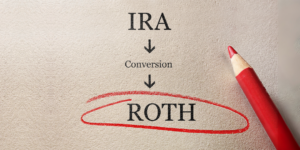When a Roth Conversion Might Make Sense
We implement Roth conversions throughout the year as part of our ongoing tax planning management for our clients. People sometimes don’t understand what’s in their Pre-tax 401K and Traditional IRA; the government owns anywhere from 15-30% of your funds because you haven’t paid taxes yet on those contributions. They are compounding higher and higher each year you wait. This increases your tax bill. Those deductions are often like interest loans you are paying to the government, so we like to take advantage of the tax codes that we have today and plan the best way to pay. As Ben Franklin said, “Death and taxes are the only constant in life.” Here are a few examples of when it might make sense for a Roth Conversion. We suggest you explore advice and guidance from a CFP professional or a CPA and not do this alone.
A Roth conversion involves transferring funds from a traditional retirement account, like a traditional IRA or 401(k), into a Roth IRA. This process allows you to pay taxes on the converted amount now rather than when you withdraw the funds in retirement. Here’s a detailed look at how it works and when it might be advantageous:
How a Roth Conversion Works
Transfer Funds: Move money from a traditional IRA or 401(k) to a Roth IRA.
Pay Taxes: The amount converted is added to your taxable income for the year, and you pay taxes at your current income tax rate.
Tax-Free Growth: Once in the Roth IRA, the funds grow tax-free, and qualified withdrawals in retirement are also tax-free.
When to Consider a Roth Conversion
Lower Tax Bracket: If you expect to be in a higher tax bracket in retirement, converting now while you’re in a lower tax bracket can save you money in the long run.
Market Downturn: Converting during a market downturn can be beneficial because the value of your investments is lower, meaning you’ll pay taxes on a reduced amount. For example, if your IRA value drops from $100,000 to $85,000, you’ll pay taxes on the $85,000 instead of the higher amount.
Future Tax Increases: If you anticipate future tax rate increases, converting now can lock in the current lower rates.
Retirement Planning: To avoid required minimum distributions (RMDs) from traditional IRAs, converting to a Roth IRA can be a good strategy since Roth IRAs do not have RMDs during the account holder’s lifetime.
Example Scenario: Imagine you’re currently in the 22% tax bracket and expect to be in the 24% bracket in retirement. Converting $20,000 now would add $20,000 to your taxable income, resulting in $4,400 in taxes. If you wait until retirement, you might pay $4,800 in taxes on the same amount due to the higher tax bracket.
Considerations
Tax Impact: Be mindful of the conversion’s tax impact, as it could push you into a higher tax bracket for the year.
Timing: Spreading conversions over multiple years can help manage the tax burden and avoid significant jumps in taxable income.
A Roth conversion can be a powerful tool for tax planning and retirement strategy. Consulting with a financial advisor can help you determine the best approach based on your circumstances.
Do you have any specific questions about how a Roth conversion might fit into your financial plan? Call us and we’ll find out what makes sense for you!
Chris graduated from the University of Maine, where he played hockey on a scholarship, and retired from professional hockey in 2007. In the community, he remains engaged, serving as a youth hockey coach. Chris holds the CERTIFIED FINANCIAL PLANNER™. Outside the office, he enjoys trying new food and wine, reading, traveling, playing golf and hockey, fat tire biking, and donating to local charities. His passions include being a husband and dad, lake life with the family, watching his son and daughter play sports, and spending time with his wife. To learn more about Chris, connect with him on LinkedIn.

